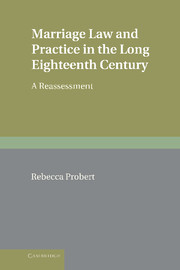Book contents
- Frontmatter
- Contents
- Preface
- 1 Introduction
- 2 The misunderstood contract per verba de praesenti
- 3 The myths of ‘informal’ and ‘common-law’ marriage
- 4 The little-considered marriage practices of non-Anglicans
- 5 The unacknowledged regularity of clandestine marriages
- 6 The eventual passage and actual terms of the 1753 Act
- 7 The unappreciated success of the 1753 Act
- 8 The unexplored judicial interpretation of the 1753 Act
- 9 The overlooked response of non-Anglicans
- 10 Conclusion
- Index
- References
9 - The overlooked response of non-Anglicans
Published online by Cambridge University Press: 10 February 2010
- Frontmatter
- Contents
- Preface
- 1 Introduction
- 2 The misunderstood contract per verba de praesenti
- 3 The myths of ‘informal’ and ‘common-law’ marriage
- 4 The little-considered marriage practices of non-Anglicans
- 5 The unacknowledged regularity of clandestine marriages
- 6 The eventual passage and actual terms of the 1753 Act
- 7 The unappreciated success of the 1753 Act
- 8 The unexplored judicial interpretation of the 1753 Act
- 9 The overlooked response of non-Anglicans
- 10 Conclusion
- Index
- References
Summary
As discussed in Chapter 4, non-Anglicans were very much in the minority at the time the 1753 Act was passed, and the Church of England ‘controlled something approaching a monopoly of English religious practice’. Yet this period of unrivalled popularity was to be brief, as new sects sprang up in the second half of the century, and older ones attracted new adherents. Since it has been widely assumed that non-Anglicans could marry according to their own rites before 1754, the impact of the 1753 Act on such groups is often presented in stark terms. According to Gibson, for example, the Act ‘forced Catholics and Dissenters to flout either the law or their consciences’. Most commentators take the view that, faced with such a choice, couples preferred to comply with the law and that the requirements of the legislation were observed by all denominations, with Protestant dissenters and Catholics alike submitting to the Anglican rite.
Yet there have been remarkably few studies devoted specifically to this topic, and one must be as sceptical of views that agree with one's own as of those that do not, unless and until those views are supported by clear evidence. Certainly evidence is lacking in the arguments of the few who have put forward the alternative view: O'Donovan, for example, states simply that Catholics and Dissenters ‘did not conform’; Parker notes the existence of 3,451 dissenting chapels and speculates – his own word – that ‘a large proportion of these conducted their own marriage services’, while Olive Stone has suggested that up to one-third of all marriages were non-Anglican and so void but provides no authority for this figure.
- Type
- Chapter
- Information
- Marriage Law and Practice in the Long Eighteenth CenturyA Reassessment, pp. 314 - 339Publisher: Cambridge University PressPrint publication year: 2009

